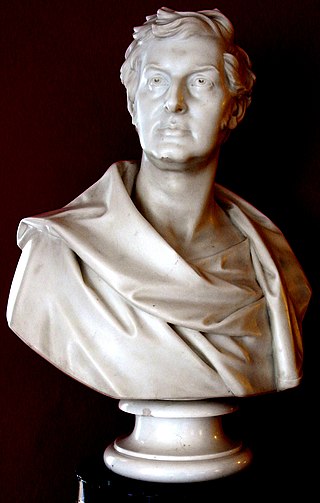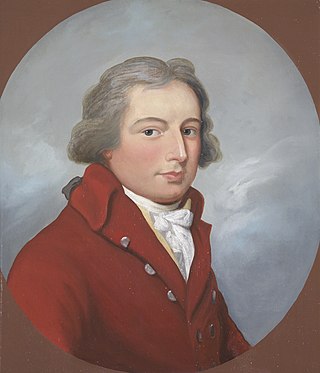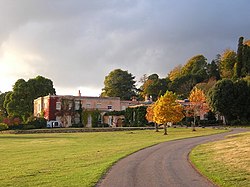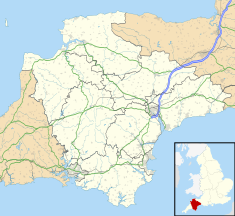
Sir Thomas Dyke Acland, 10th Baronet was a British politician and baronet.

Sir Richard Thomas Dyke Acland, 15th Baronet was one of the founding members of the British Common Wealth Party in 1942, having previously been a Liberal Member of Parliament (MP). He joined the Labour Party in 1945 and was later a Labour MP. He was one of the founders of the Campaign for Nuclear Disarmament (CND).

Broadclyst is a village and civil parish in the East Devon local government district. It lies approximately 5 miles northeast of the city of Exeter, Devon, England, on the B3181. In 2001 its population was 2,830, reducing at the 2011 Census to 1,467. An electoral ward with the same name exists whose population at the above census was 4,842.

Holnicote in the parish of Selworthy, West Somerset, England, is a historic estate consisting of 12,420 acres of land, much situated within the Exmoor National Park.

Sir Hugh Acland, 5th Baronet was an English Member of Parliament, from a family of Devonshire gentry. He obtained a confirmation of the family baronetcy in 1678, and served as a Member of Parliament for two boroughs in Devon in 1679 and from 1685 to 1687. Never very active in national politics, he was one of the many Tories estranged by James II's pro-Catholicism, but remained a Tory after the Glorious Revolution. He continued to hold local office in Devon off and on until his death in 1714, when he was succeeded by his grandson.

Sir Charles Thomas Dyke Acland, 12th Baronet, DL, JP, of Killerton in Devon and of Holnicote in the parish of Selworthy in Somerset, was a large landowner and a British politician and Barrister-at-Law. He was known to family and friends as "Charlie", but demanded to be known in public as "Sir Thomas", not only because that was the traditional name of the Aclands, there having been a "Sir Thomas Acland" at Killerton for 170 years, but also because following the creation of a second and much newer Acland Baronetcy in 1890, for his uncle Sir Henry Wentworth Acland, 1st Baronet, he wished people to know "which was the real head and owner of Killerton".

Goodleigh is a village, civil parish and former manor in North Devon, England. The village lies about 2+1⁄2 miles (4 km) north-east of the historic centre of Barnstaple. Apart from one adjunct at the south, it is generally a linear settlement.

Sir Hugh Acland, 6th Baronet of Killerton Devon was a British landowner and politician who sat in the House of Commons from 1721 to 1727.

Sir Thomas Dyke Acland, 7th Baronet of Killerton in Devon and Petherton Park in Somerset, was Member of Parliament for Devon, 1746–1747, for Somerset, 1767–1768, and was High Sheriff of Somerset in 1751. He was a prominent member of the West Country gentry, and a famous staghunter who used as his hunting seats his wife's Exmoor estates of Pixton and Holnicote.

Sir Thomas Dyke Acland, 9th Baronet of Killerton in Devon and Holnicote in Somerset, was a prominent landowner and member of the West Country gentry. He was especially noted for his passion for staghunting, in which respect he took after his father. Like his father he was known locally in Devon and Somerset as "Sir Thomas his Honour".

John Veitch was the Scottish horticulturist who founded the Veitch dynasty who created the Exeter based firm of Veitch Nurseries.

James Veitch was the second in a long line of horticulturists who established the renowned family business Veitch Nurseries.

Huntsham is a small village and civil parish, formerly a manor and ecclesiastical parish, in the Mid Devon district of Devon, England. The nearest town is Tiverton, about 5.8 miles (9.3 km) south-west of the village. The parish is surrounded clockwise from the north by the parishes of Bampton, Hockworthy, Uplowman and Tiverton; it is bounded on the east by the River Lowman and by a minor road on Bampton Down to the north west, where it reaches a maximum height of 914 feet (279 m). In 2001 the population of the parish was 138, down from 222 in 1901.

Sir John Acland of Columb John in the parish of Broadclyst, Devon, was an English knight, landowner, philanthropist, Member of Parliament and Sheriff of Devon. He was one of John Prince's Worthies of Devon.

John Acland was described as "the first of the [Acland] family to emerge from the shadows of history as a visible human being". His great-grandson was the Royalist colonel Sir John Acland, 1st Baronet of Columb John. Little if anything is known of his life and career, he was possibly a minor Tudor official, but he is chiefly remembered for his surviving portrait which is displayed at Killerton House, the earliest surviving image of an Acland and one of the most cherished in that family's former collection, now owned by the National Trust.

The estate of Acland in the parish of Landkey, near Barnstaple in North Devon, England, was from 1155 the earliest known seat of the influential and wealthy family of Acland, to which it gave the surname de Acland. It is situated about 3/4 mile north-east of the village of Landkey, from which it is now cut off by the busy A361 North Devon Link Road.

Tetton is an historic estate in the parish of Kingston St Mary in the English county of Somerset. The present grade II* listed Tetton House dates from 1790 and was enlarged and mainly rebuilt in 1924–6 by Hon. Mervyn Herbert (1882–1929) to the design of the architect Harry Stuart Goodhart-Rendel.

Mount Radford is an historic estate in the parish of St Leonards, adjacent to the east side of the City of Exeter in Devon.

Columb John in the parish of Broadclyst in Devon, England, is a historic estate that was briefly the seat of the prominent Acland family which later moved to the adjacent estate of Killerton.
The descent of the Holnicote estate in Somerset, England, is as follows:





















